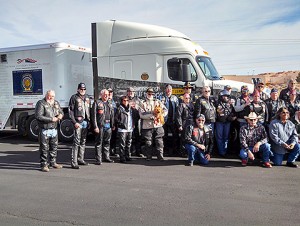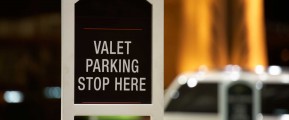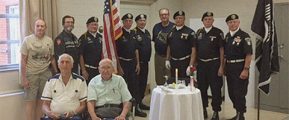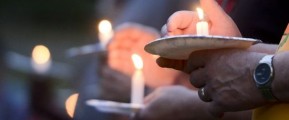Facing the Wall

The throbbing roar of fifty motorcycles announced the motorcade. Most of the riders had longish hair, beards, and mustaches. This gray brigade seemed serious, proud, and glad the trip was over. They had been in formation since leaving Page, Ariz., escorting a truck pulling a trailer containing the Traveling Vietnam Veterans Memorial. Snow-covered peaks and mesas punctuated the horizon. The procession entered the parking lot of Zion Harley in Washington City, Utah, on March 11, 2015.
Southern Utah Chapter 961 was the host and custodian of the Wall while it was in Washington County. On the half-size replica of the granite memorial in Washington, D.C., each name was etched into the metal surface. Harley Davidson had made a large donation, including use of its parking lot.
The fifty-foot trailer pulled in, and everyone began to unload the panels and set up the Wall. People worked together for a common cause. The trailer, loaded with military precision, was unloaded the same way. If you want something done, ask the military. Word came down that we would have to fill sand bags. WTF! The red sand behind the parking lot became our next work station. People started to bitch (very military like), but when the bags arrived, we went to work.
In little over two hours the Wall was up. Hard to believe it had just been on the road. We took a break, hung around, and just checked things out. There was a feeling of relief but also: “What next?” We talked generic military bullshit, when we would come back, and what to expect when we did. I always thought there would be enough people to take care of the needed tasks. There was, but they still made us wear a one-size-fits-all vest that didn’t fit anybody. Oh, maybe it fit the ROTC and young cadet volunteers. The gray brigade seemed to be about forty years and fifty pounds away from a proper fit.
The Traveling Wall remained in southern Utah for five days. I attended the closing ceremonies. An honor guard, a junior high choir, and an Irish band paid homage to the sacrifices of Vietnam veterans. The service anthems were sung; the Army hymn brought an unexpected tear to my eye. A few members of Chapter 961 spoke and our chaplain gave the closing prayer.
When I got home that Saturday evening I was totally spent. I had a splitting headache and just felt kind of weird and empty. I couldn’t put my finger on the reason. I had a restless night without much sleep. After much reflection the next day I began to piece things together.
I was torn between expressing my own grief and being thought of as unmanly. “Men are taught to overcome grief, not experience it, ” Dr. Alan Wolfelt wrote in his paper, “Men in Grief.” He claims that men and society in general had little tolerance for the expression of grief. I was taught to suffer in silence; if I didn’t, it was a sign of weakness. But right now, I needed some help. My father must have had anxiety and felt vulnerable, but like most World War II veterans, he never said a word about his experiences. I was confused, then and now. Did anybody know or care about me if I was silent? Maybe a lot of these guys with PTSD turned to drugs and alcohol instead of grieving. It had seemed easier for me to get stoned or drunk than to mourn. It had taken me about forty years to ask for help or support. Who knows, maybe it was possible to grieve and not be a sissy.
During my recently ended twenty-year career as an alternative education teacher, I had grief counselors help my class after the death of a classmate. I wasn’t sure if looking at the Five Stages of Grief would help me, but I looked them up. They are: Denial and Isolation, Anger, Bargaining, Depression, and Acceptance. Where was I on that list?
When I was at the Wall interacting with people I was okay. I enjoyed helping people find a name. I especially liked discussing the history of the Wall and what happened to all the things people left there. A motorcycle that traveled with the Wall had been left at the Wall in D.C., not sent to the Vietnam Veterans Memorial Collection like all of the other things left at the memorial. It was fun to talk about. The total number of names and how many women were included were rich topics for discussion.
As a retired teacher and people-person, I thoroughly enjoyed interacting with the visitors. But when it concluded, I felt hollow and unfulfilled. True, I did have a reverse Wall moment when I looked for a name and didn’t find it. That was a relief. But after the Wall was packed away and I was alone with my thoughts, things got difficult.
Some things I know for sure. Everybody takes something to the Wall and everybody leaves something there. That can be spiritual, metaphorical, or physical. Wherever the Wall is raised is sacred ground. I believe this with my entire heart. However, it is billed as the “Wall that Heals.” But I had no feelings of healing. I was sad and depressed. I suffered from survivor guilt like many vets. What did it all mean?
Experiencing the Vietnam Veterans Memorial is different for everybody; it can also be different each time you see it. I first saw it in Washington, D.C.; it took me three days to get there. Avoidance is a common PTSD symptom. But I remember thinking that The Wall was done the right way. It didn’t glorify the Vietnam War, but it paid tribute in an appropriate manner. The shape and form accurately reflect the experience. Most vets agree with the design’s restraint. When viewed in its entirety, it is breathtaking. From the apex to the two waning ends, it conveys a feeling of fading away or the culmination of a meaningful experience.
I had a friend who got depressed because he said his volunteering to go to Vietnam was a mistake. His decision wasn’t wrong. He went at the time because he thought it was the right thing to do. He shouldn’t second-guess himself. America’s decisions made the war what it was.
Another guy said he was bringing his buddies home. He lost quite a few men whose names are on The Wall. Now he was bringing them to where he lives. I thought that was poignant and moving. At least his friends can be with him for a while.
I believe that many people are looking for a sense of closure. Civilians, servicemen, and servicewomen want to see a name so that they can make their peace. Some people just want to say good-bye and that is okay, too.
Even if you didn’t have a plan before you go to The Wall, you need to ask yourself: “Why did I go?” Maybe you had a plan that changed after you went. The important thing is not to beat yourself up over it.
The first time I went to The Wall was mainly out of curiosity. Then, twenty-five years later, it was to see if my acceptance of PTSD and dealing with it made any difference. It did, but I wasn’t prepared for the emotional drain. I thought to myself almost lyrically: “When will the pain return to the darkness from whence it has come?” Now after my recent experience I feel better and more centered.
Some people never go to The Wall, while others return again and again. There are no rules. So do what you want, but don’t ignore The Wall. Even if you don’t go, you need to figure out how you feel about the whole Southeast Asian experience. I won’t ever forget the more than 58, 000 names; you shouldn’t either. The Vietnam Veterans Memorial doesn’t glorify, but recognizes the sacrifices we made. What am I to do now? What’s left for me?
By Larry Harris




